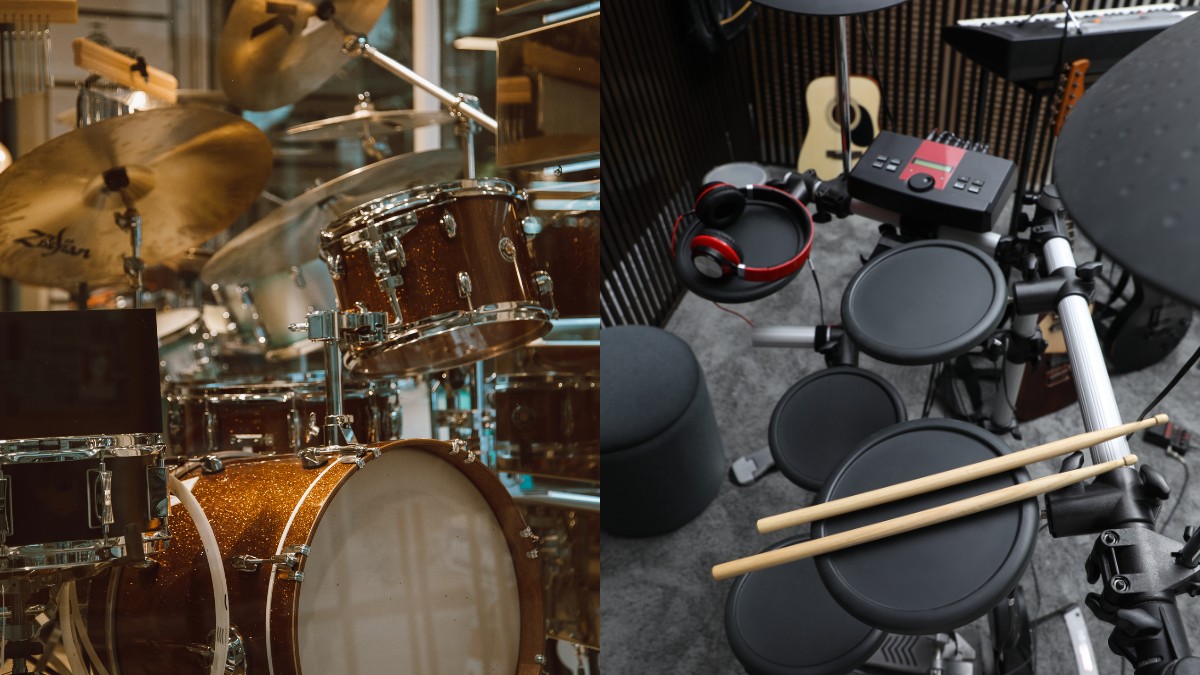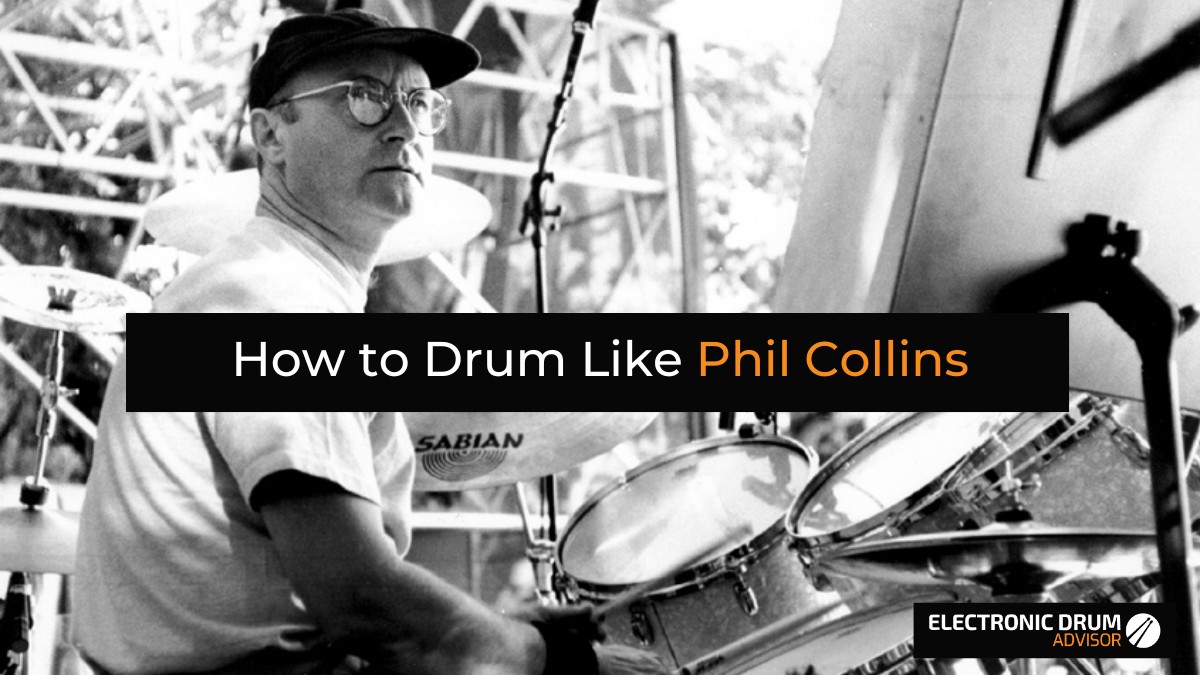Is It Better To Learn Drums Using an Acoustic Or Electric Kit?

Acoustic drums provide a more natural playing experience, allowing beginners to build a strong foundation, but electronic drums are far more practical for many living situations, and including built-in tools such as metronomes and exercises that can improve skill development. The best type of drum set is the one that you’ll be able to practice on most.
It’s generally better to learn drums on an acoustic kit, but if you’re going to struggle with getting practice in due to noise constraints then an electronic set is far better than not practicing at all. If doing so, it’s worth trying to get at least some time on an acoustic drum set, such as through drum lessons or in a rehearsal space, to give you the feel of playing on an acoustic kit.
Contents
Transitioning Between Acoustic and Electronic Drums
It’s quite easy to transition between acoustic and electronic drums though it can take a bit of an adjustment. Though, higher-end electronic drums tend to emulate the feel of acoustic drum sets the best, e.g. the Roland TD-27KV2 or the Roland TD50-KV2.
Shifting from electronic to acoustic drums can require drummers to refine their skills and control over dynamics since acoustic drums demand more precision in striking force and finesse. But this is worth the effort, as playing on the genuine, tactile sensation of playing acoustic drums is immensely satisfying and inspiring.
Acoustic vs. Electronic Drums
If you’re wondering which one to get and want to compare both then here is a quick pros and cons of both drums so that you can get an idea of the differences between the two. I will also go into detail a bit further in the article so make sure to continue reading!
Acoustic Drums
Pros:
- They provide a traditional and authentic feel.
- They have a great stage presence when performing.
- They have a great dynamic range since you can hit them in a number of ways.
Cons:
- They’re loud.
- They take up a lot of space.
- They are hard to transport.
- They take quite a while to set up.
Electronic Drums
Pros:
- They’re low-volume.
- They don’t take up as much space.
- Easier to transport.
- Has built-in training tools and a metronome.
- Feature-packed with lots of different built-in sounds.
Cons:
- Doesn’t feel as good as acoustic drums (Though there are some improvements in this area as they further develop new technologies to mimic the feel of acoustic drums).
- Doesn’t really have the stage presence that the acoustic drums command, though roland vad sets are coming close to this.
- A somewhat higher barrier of entry (Can cost a bit more to get into electronic drums rather than acoustic ones).
To learn a lot more about the differences between acoustic and electronic drums, check out an article that goes deeper into comparing both.
Playability and Feel
Acoustic drums provide a traditional and authentic feel that many drummers find incomparable. The drumheads’ responsiveness and natural resonance create an organic and immersive experience. Playing the cymbals also adds to the overall experience, with nuances like playing the bell, edge, or body affecting the tone. This feel is crucial for drummers to recreate the captivating energy and dynamics of their live performances.
While older electronic drum kits don’t really feel as good as acoustic ones, advances in technology have led to the development of mesh heads that resemble acoustic drums much more closely. Moreover, electronic drums have become much better at capturing subtle playing techniques like ghost notes and cymbal swells, which has made them a viable option for drummers.
Noise Considerations
When you’re deciding between acoustic and electronic drums, don’t forget about the noise factor! Acoustic drums can get pretty loud and cause some serious issues, like angry neighbors, noise complaints, or even hearing problems if you’re not careful to protect your hearing.
On the flip side, electronic drums are a drumming option that won’t have you constantly worrying about noise levels. You can pop on some headphones or plug into an amp and tweak the volume to fit your surroundings, which is great for practicing in shared spaces or noise-sensitive areas. Plus, you won’t lose the drumming vibe.
Of course, noise isn’t always a buzzkill. Like in live performances, the raw power and boom of acoustic drums give an unbeatable high that electronic drums can’t quite match. But hey, electronic drums still rock on stage, thanks to their quick sound tweaks and an endless variety of beats and effects that work with different music styles.
Space and Portability
Acoustic drum kits are big and take up lots of space. Plus, they have lots of separate pieces, like drums and cymbals, which can be tough to set up quickly, especially if you don’t have much room to work with.
On the other hand, electronic drum kits are generally more compact (but not always, such as the Alesis strike pro se). They usually have fewer components due to their modular design. This not only saves space when setting up in smaller areas but also makes transportation easier when moving around.
While acoustic drums are way more fun to play on stage and tend to look way cooler, electronic drums have some advantages. They’re far easier to transport, set up, and connect to a PA system.
Cost Comparison
Let’s talk about the cost comparison between acoustic and electronic drums. When purchasing a kit, it’s not just about the initial cost, but also ongoing maintenance and extras. Acoustic drums need more than just the drums themselves – think cymbals, stands, and repairs. Plus, they require regular maintenance and replacements, which can add up.
Electronic drums may be pricier at first for decent models, but they come with everything you need and have lower maintenance costs. They also come with a range of effects and sounds, so you don’t need to buy as many extras. Plus, they’re often quieter, saving you from soundproofing costs if you’re in a shared space.
Features and Customization
It’s important to check out both types of drum kits in terms of how flexible, adaptable, and customizable they are.
Acoustic drums have a classic, natural sound that lots of drummers love. Even though they may seem less versatile than electronic kits, acoustic drums can still be personalized in lots of ways. You can try different drumheads, tuning methods, and damping techniques to shape your own unique sound.
On the flip side, electronic drums are packed with features that cater to the needs of modern drummers. One of the biggest advantages is the sound module, which often has hundreds or even thousands of drum and percussion sounds to explore without needing tons of physical instruments.
And there’s more to electronic drum kits than just sound. You can also customize the physical layout and configuration of the kit. Drum pads and cymbals can be rearranged or expanded, so you can have a comfortable, personalized setup. Plus, many electronic drum modules come with MIDI capabilities, so you can connect to computers or recording software and unleash your creativity.
Electronic drum kits also often come with practice tools like metronomes, learning exercises, and play-along tracks, which are great for developing your skills.
Live Performances and Recording
In live performances, acoustic drums are often the go-to choice for their natural, authentic sound that can bring an unrivaled energy to the stage. However, in smaller venues, the volume can be an issue, and getting a good sound can require a lot of effort from sound engineers.
Electronic drums may not have the same raw power as acoustic drums, but they offer several advantages for live performances and recordings. They are much easier to control the volume of, which makes them great for small venues or places with noise restrictions. Connecting them to amps or PA systems is a breeze too. And with their extensive sound libraries and effects, electronic drums offer drummers endless possibilities for exploring different genres and styles.
Pros and Cons for Beginner Drummers
Starting with acoustic drums, one of the main advantages is the authentic playing experience they offer, allowing beginners to develop a strong foundation in technique, dynamics, and responsiveness. However, the primary drawback for beginners exploring acoustic drums is the noise levels, which can pose difficulties when practicing in shared living spaces, apartments, or noise-sensitive environments. Additionally, acoustic drums can take up considerable space.
On the other hand, electronic drums offer several benefits for beginner drummers. First and foremost, their reduced noise levels make them an ideal option for practicing in a wider range of environments. Electronic drum kits often come with built-in practice tools, providing valuable resources for skill development and self-paced learning. However, the drawbacks of electronic drums lie in the potential disparity in feel and responsiveness compared to acoustic drums.
Conclusion
Ultimately, the suitability of acoustic and electronic drums for different environments hinges on individual preferences, musical goals, and the specific circumstances each drummer encounters.
As you embark on your drumming journey or contemplate which drum kit better aligns with your evolving musical aspirations, we hope this article provides valuable insights to help you make an informed decision. Embrace your passion for percussion, explore the unique advantages of each drum type, and remember that the best choice is not definitive but rather tailored to your distinct situation and desires as a drummer.







